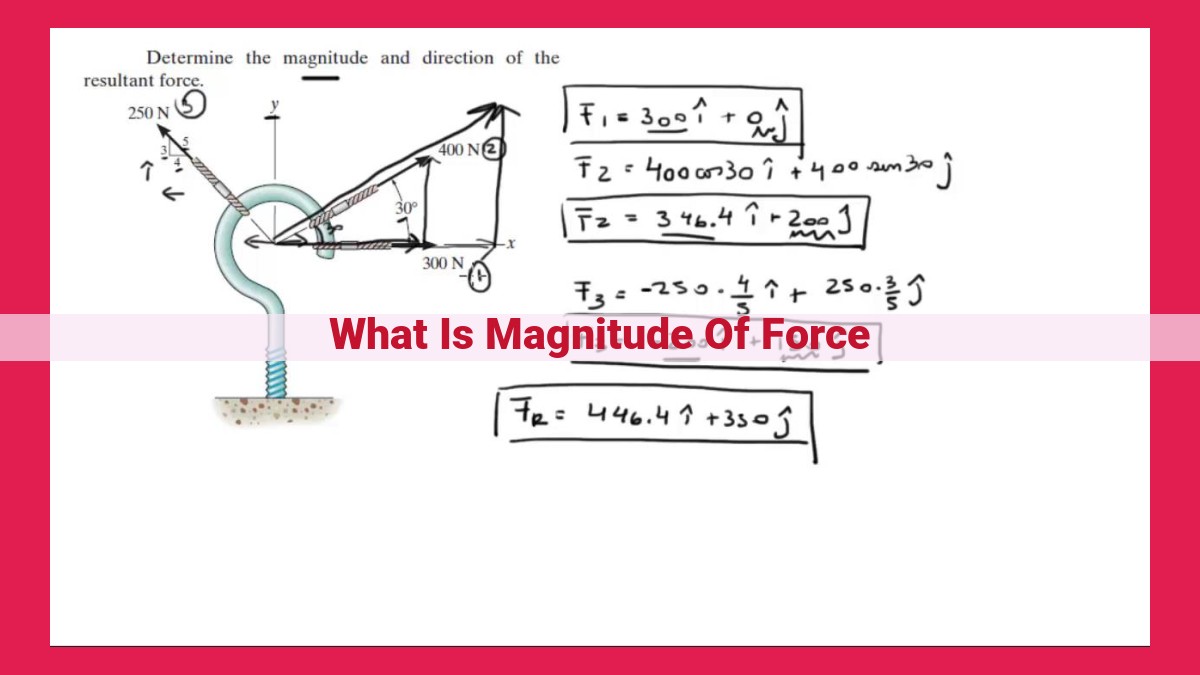Understanding Force Magnitude: Measuring Strength And Intensity Effectively

Magnitude of force is a scalar quantity that measures the strength or intensity of a force. It is distinct from the direction of the force, which indicates the line along which the force acts. The magnitude of force is measured in newtons (N), with one newton defined as the force required to accelerate a 1-kilogram mass at a rate of 1 meter per second squared. Force is a vector quantity, meaning it has both magnitude and direction, and the net force acting on an object is the vector sum of all individual forces. When the net force is zero, the object remains at rest or continues at constant velocity.
Understanding Magnitude of Force
In the tapestry of physics, force plays a pivotal role in shaping the dynamics of our world. Whether it’s the gentle breeze rustling through leaves or the relentless pull of gravity keeping us grounded, forces are the invisible threads that orchestrate every movement and interaction.
One crucial aspect of force is its magnitude, a measure of its strength or intensity. It quantifies the potency of a force, telling us how much “push” or “pull” it exerts. Just as a ruler measures length, the newton (N) serves as the unit of force, named after the legendary physicist Sir Isaac Newton.
Magnitude versus Direction
It’s essential to distinguish between the magnitude and direction of force. While magnitude tells us the force’s strength, direction indicates the line along which the force acts. Together, these two characteristics fully describe a force. For instance, a 50 N force directed to the east differs from a 50 N force directed to the west, even though they have the same magnitude. This distinction is crucial because forces can combine and cancel each other out, depending on their directions.
Measuring the Magnitude of Force: The Newton
Understanding the strength or intensity of a force is crucial in comprehending the interaction between objects. This concept is quantified by the magnitude of force, a fundamental characteristic of forces that describes their potency. The newton (N), named after Sir Isaac Newton, serves as the standard unit for measuring the magnitude of force in the International System of Units (SI).
To grasp the significance of the newton, consider the following definition: one newton is the force required to accelerate a one-kilogram mass at a rate of one meter per second squared (1 kg m/s²). In simpler terms, it is the force needed to cause an object with a mass of one kilogram to change its velocity by one meter per second in just one second.
Various instruments are used to measure the magnitude of force, each with its own strengths and applications. Force gauges, also known as dynamometers, are portable devices that directly measure force by applying a counterforce to the object being tested. Spring balances, on the other hand, utilize the deformation of a calibrated spring to indicate the magnitude of force acting on them.
By understanding the magnitude of force, we gain invaluable insights into the nature of interactions between objects. This knowledge underpins our understanding of motion, equilibrium, and the behavior of objects under the influence of external forces.
The Vector Nature of Force: Unveiling the Directionality of Force
In the realm of physics, forces are not mere numbers; they possess both magnitude and direction, making them vector quantities. This means that forces are much like arrows: they have a size (magnitude) and a specific orientation (direction).
Understanding the vector nature of force is crucial because it allows us to comprehend how multiple forces can interact to influence the motion of objects. When several forces act on an object simultaneously, we use vector addition to calculate the net force, which is the vector sum of all individual forces.
The net force is the force that ultimately determines the object’s acceleration. If the net force is zero, the object will either remain at rest or continue moving at a constant velocity. However, a non-zero net force will cause the object to accelerate in the direction of the net force.
Therefore, the vector nature of force is not just a mathematical concept but an essential aspect of understanding how forces shape the dynamics of the world around us. By unraveling the directionality of forces, we can unravel the secrets of motion and predict the behavior of objects in a vast array of scenarios.
**The Sum of Forces: A Balancing Act**
Imagine you’re standing on a seesaw, trying to balance your weight against your friend’s. Each of you exerts a force on the seesaw, attempting to tilt it in their direction. The direction of each force is crucial, but so is its magnitude, which measures the strength of the force.
To quantify this strength, we use the newton (N) as our unit. Each newton is the force needed to accelerate a specific mass at a particular rate. When multiple forces act on an object, we can sum their magnitudes to determine the net force.
Just like on the seesaw, when the net force is zero, the object remains in equilibrium. This means it’s either at rest, or if it’s moving, it continues to move at a constant velocity. Conversely, if the net force is nonzero, the object accelerates in the direction of the net force.
Example: If you push a ball with a force of 5 N to the right, and your friend pushes with a force of 3 N to the left, the net force is 5 N – 3 N = 2 N to the right. This force will cause the ball to accelerate to the right.
In summary, the sum of forces principle tells us that the net force acting on an object is the vector sum of all individual forces. This principle helps us understand and predict the motion of objects in our world, from the balanced dance on a seesaw to the trajectory of a rocket soaring through space.